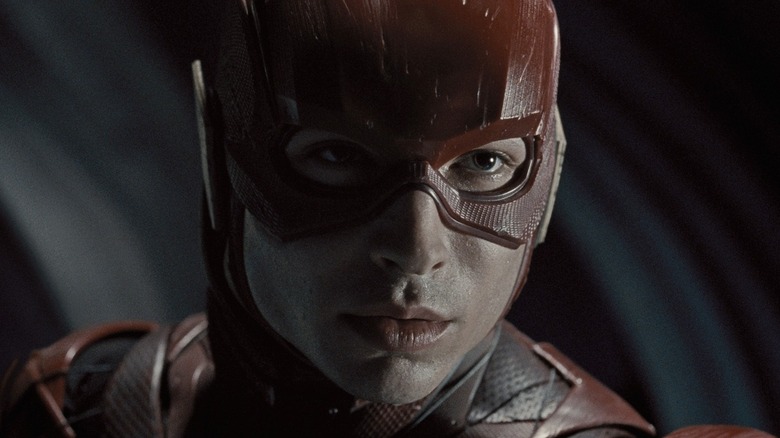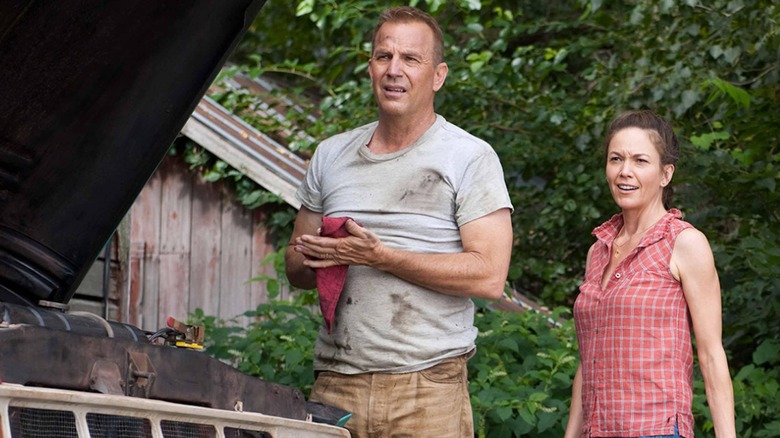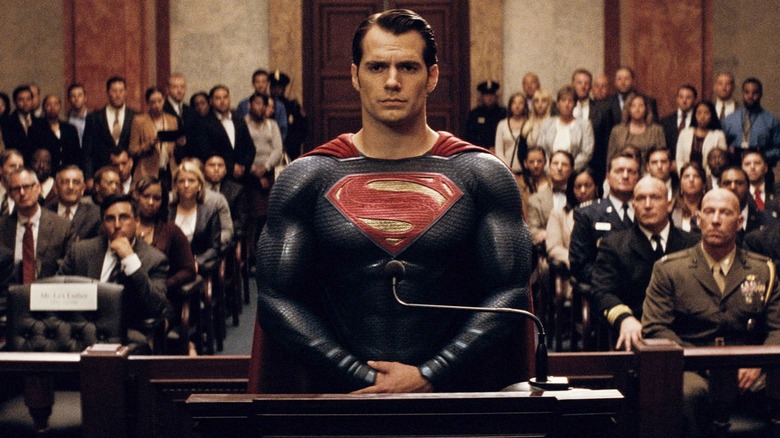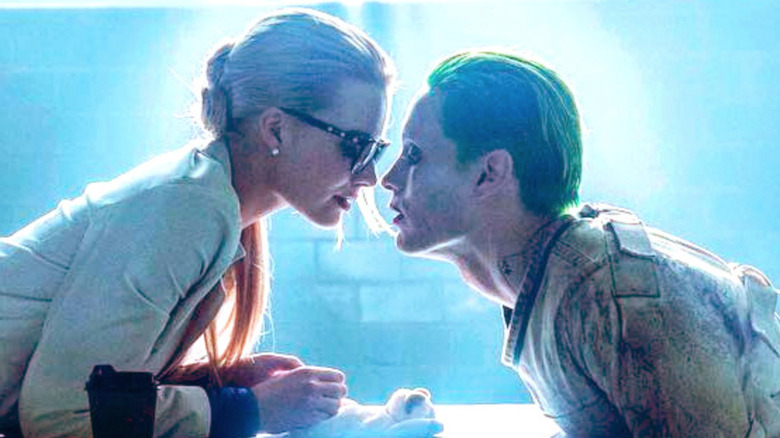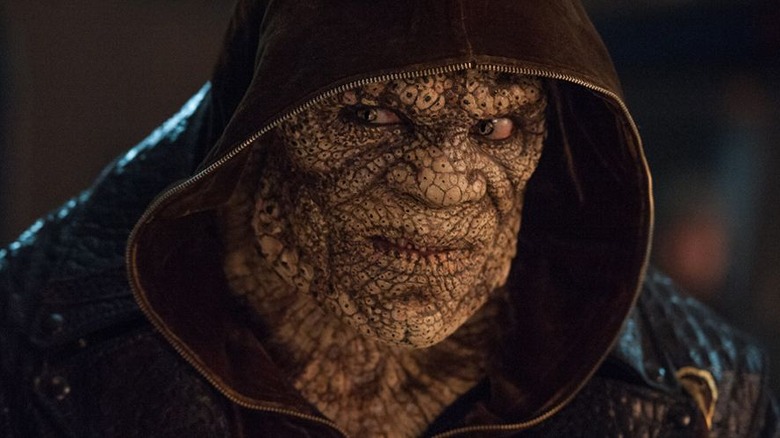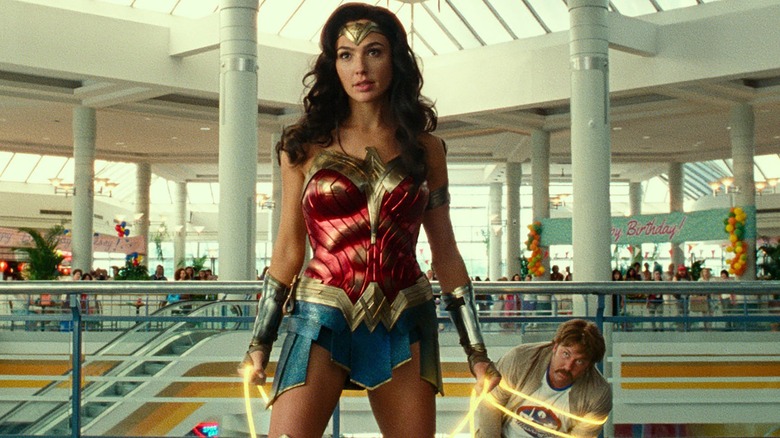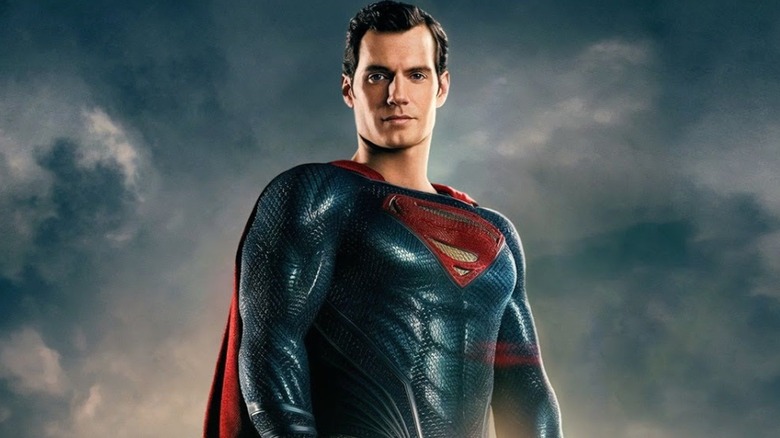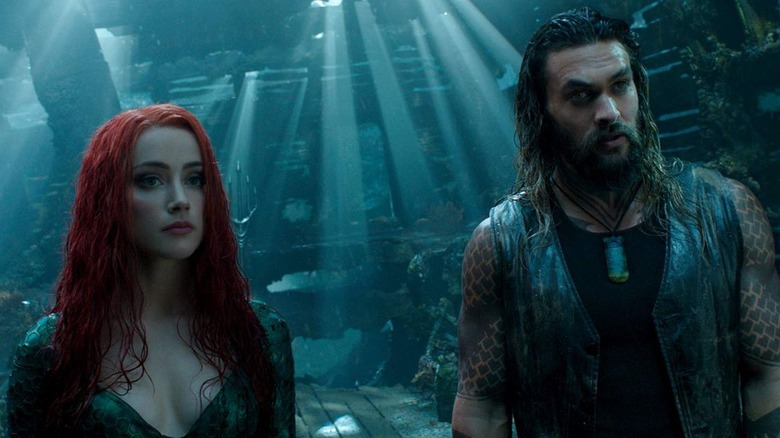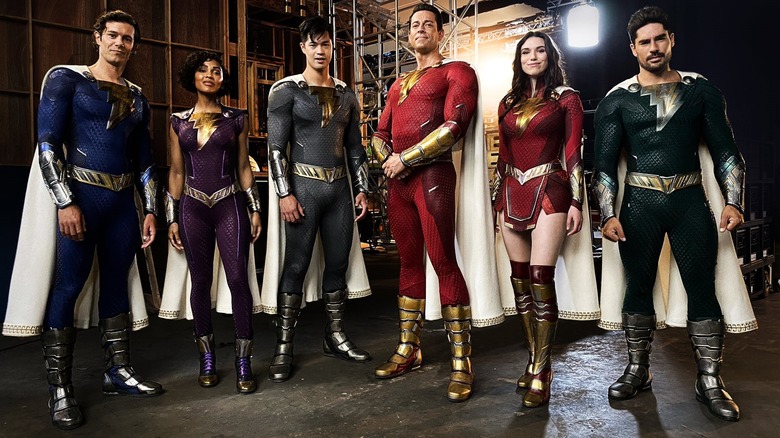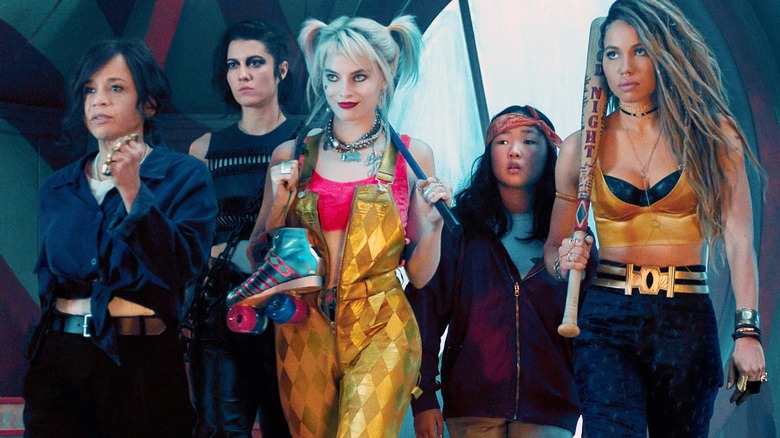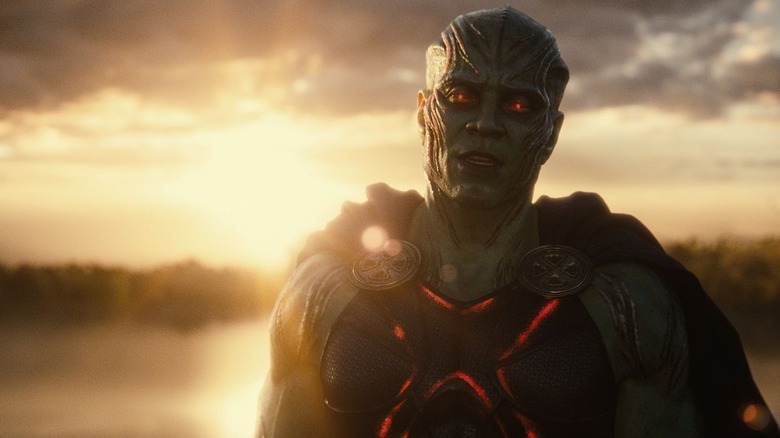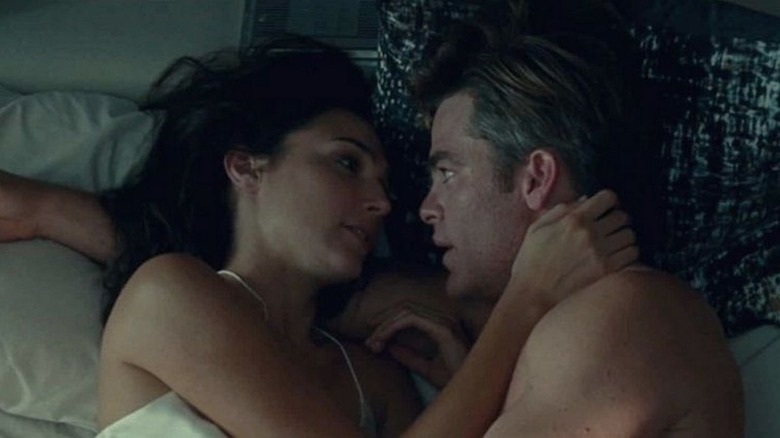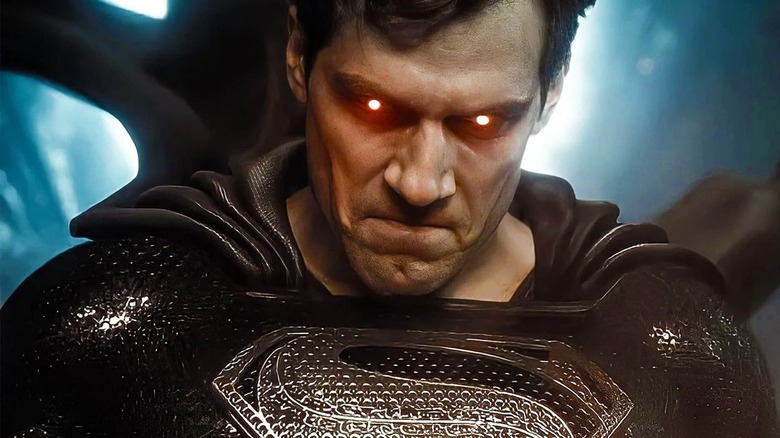Questionable Things We Ignore In The DCEU
The discourse surrounding the DC Extended Universe of interconnected live-action films has been everything except "quiet." Nearly every film in the franchise has proven divisive among its viewers (some significantly more than others), and there aren't many aspects of the films that aren't hotly debated. Despite this, however, there are still some "questionable" aspects that have been ignored in favor of bigger game, and this list will bring all of them to light.
Forget the endless debates over Batman's killing spree in "Batman v Superman: Dawn of Justice" and the many differences between the two different cuts of "Justice League." Instead, ponder how the subtle details of Superman's indestructible costume could possibly have changed between movies, wonder how the Atlanteans can speak underwater as they would on land without explanation, and study the finer mysteries of a cinematic universe that is still struggling to find its footing nearly a decade after it began.
Everything about Jonathan Kent's death in Man of Steel
The DCEU's first official film still has one of the franchise's worst scenes. Attempting to explain why Clark/Kal-El (Henry Cavill) is so unwilling to reveal himself and his powers to the world, "Man of Steel" features a scene that's meant to drive home just how seriously Kevin Costner's Jonathan Kent takes Clark's secrecy.
Clark and his adoptive parents are driving home as a tornado suddenly appears and, desperate to escape, they leave their car and take cover underneath an overpass, but accidentally leave their dog inside the car. Jonathan decides to rush out and free the dog but is pinned between two cars by the storm and trapped. Afraid Clark will reveal his powers if he tries to save him, Jonathan motions for Clark to stay where he is and lets the storm kill him.
It's difficult to explain just how many questionable decisions occur in this scene. To start, why did Jonathan try to save the dog? Not only was it obviously a bad idea in general to run back out towards a tornado, it's easily something that Clark could have safely done without revealing his powers. The most unbelievable part about the scene, however, is that Clark wouldn't even try to save his father's life. He's Superman. He saves people. It's what he does, and the idea that he would just stand there as his father dies in front of him is completely antithetical to the character.
How did Superman change his costume before Batman v Superman?
To say that 2016's "Batman v Superman: Dawn of Justice" was controversial would be perhaps the greatest understatement of the DCEU, but there is one decision in the film that has seemed to largely go unnoticed: The details of Superman's costume have been changed from "Man of Steel."
Though there are minor differences throughout the suit's cuffs, logo placement, boots, and neckline, the most notable difference between the two is the "belt." In "Man of Steel," it was golden and ended on a circular shape. In "Dawn of Justice," however, the belt is silver and has a more box-like "belt buckle." The suit's classic emblem was also changed to include a line through the middle of the "S" alongside Kryptonian text that runs the length of the letter.
Though it's normal for superhero costumes to be changed or updated between films, this is a slightly unique instance as Superman's costume is supposed to be indestructible. If that's the case, how did Superman make the alterations? It's hard to imagine it was as simple as taking it to Ma Kent and her sewing set.
Harley Quinn and the Joker's relationship should not be romanticized
During the course of David Ayer's "Suicide Squad," the Joker (Jared Leto) meets Dr. Harleen Quinzel (Margot Robbie) in Arkham Asylum, convinces her to break him out, and transforms her into Harley Quinn by throwing her into the same vat of Ace Chemicals toxins that transformed him into the Joker. This is the standard Harley Quinn origin story, but it has one major difference: this version of the Joker actually loves Harley.
In nearly every other version, the Joker has no love for Quinn. He simply uses her to pursue his true interest: Batman. "Suicide Squad," however, makes it clear that he does indeed love her when he goes back to make sure she escapes the Ace Chemicals vat alive. Joker spends the entirety of the "present day" portion of the film attempting to rescue Harley from the Squad and finally succeeds, further cementing the idea that he does actually care about her.
That's not really a good thing though. The pair's romance, even when portrayed as favorably as it is here, has been and always will be incredibly toxic. The Joker is indisputably evil and, accordingly, treats nobody well. By portraying their abusive relationship as loving, it normalizes horrible behavior and promotes the idea that people can go into relationships to "fix" their partners, which is never a good idea.
Killer Croc probably shouldn't be eating raw meat
In the opening scene of David Ayers' "Suicide Squad," viewers are granted a brief glimpse of Killer Croc's (Adewale Akinnuoye-Agbaje) personnel file. It states that his real name is Waylon Jones and that he was born with a "regressive atavism resulting in reptilian traits" that, combined with a metagene, resulted in the creature we see throughout the film.
Atavism is a "recurrence of or reversion to a past style, manner, outlook, approach, or activity" or "recurrence in an organism of a trait or character typical of an ancestral form." Essentially, the idea is that he suffers from a disease that has brought back the traits of humanity's reptilian evolutionary ancestors.
The problem is, he is still mostly human and despite the many abilities he has at his disposal, it's still almost certainly a horrible idea for him to be eating raw flesh as viewers see him do during the course of the film. It's an even worse idea to eat said meat after it's been dropped into sewage water. He isn't actually a reptile, and all of the normal health risks, such as foodborne illnesses like viruses, parasites, and toxins, will still affect him, even if his metagene might make him less susceptible than others.
Wonder Woman and Mary Marvel really shouldn't wear skirts
The skirt has been a staple of fashion design and superhero costumes for decades, but it probably really shouldn't be worn by itself by any hero who can fly. In the DCEU, both Wonder Woman and Mary Bromfield from David Sandberg's "Shazam!" wear skirts and fly.
Though their costume designs look great, anybody they fly over would have quite a view, and this has been commonly used by comic book artists for decades to overtly sexualize and objectify female heroes. One of the clearest examples of this trope is the depictions of the underage Supergirl in Jeph Loeb and Michael Turner's "Superman/Batman" #8 through #13. The story served as the classic Supergirl's reintroduction into the current DC Universe and featured the teenage superhero in a very revealing miniskirt.
Now, it's certainly possible to have heroes in skirts and not use the garments to objectify the heroines. For example, the skirt can be combined with other fashion choices to render the issue moot. Melissa Benoist's original costume on "Supergirl" paired the skirt with what were essentially leggings to ensure that this was never an issue. It's also possible to simply not depict the hero in that sort of position as the DCEU has done so far with both Diana and Mary. However, it only takes one poor creative decision to mess this up, and it might be better to avoid the issue altogether.
Superman didn't really need the team in Joss Whedon's Justice League
When "Justice League" was released in 2017, the film immediately fell under fire for a variety of criticisms. One of the most commonly overlooked issues, however, was the fact that Superman didn't really need the rest of the team to be there after they resurrected him. Though he truly would not have been able to revive himself without their help, the moment he enters the fray in the final battle is also the exact moment the conflict loses all sense of tension.
Wonder Woman, Batman, and Aquaman can't defeat Steppenwolf; Superman flies in and easily sends him flying. The Flash is struggling to rescue a handful of civilians; Superman flies in and easily carries out entire buildings of innocents at a time. Cyborg can't separate the three Mother Boxes; Superman once again flies in and immediately pulls them apart. Even though the other members of the Justice League are there, Superman ultimately does the heavy lifting, easily accomplishes what they struggle and fail to do, and basically makes them look like personal assistants in their own movie.
The Atlanteans in Aquaman can just talk underwater
When it came time to have Aquaman speak underwater with other Atlanteans in both Joss Whedon and Zack Snyder's versions of "Justice League," the characters took time to create an underwater pocket bubble of air before they could speak. In Zack Snyder's version specifically, they only ever communicated through water using high-pitched notes and gestures. Both versions of the story seemed to indicate that Atlanteans had no way to speak normally underwater.
When James Wan directed 2018's "Aquaman," however, he decided to just ... have them speak underwater. Gone were the dolphin-like vocalizations and the Atlantean-made air bubbles, and in their place were Atlanteans simply speaking like normal while they swam through the earth's many oceans.
The problem is, they never explained "how." Not only could they quite clearly not do so before, but how they could do it at all is a mystery. It is not possible to speak underwater. Sounds simply don't carry the same way they do through air. This is likely why Snyder chose to depict the Atlanteans that way in his movie, as he was going for a sort of stylistic realism in his films. Even though maintaining that for all of "Aquaman" would have been extraordinarily clunky, the fact that Atlanteans can speak underwater without issue is certainly questionable.
Children probably weren't the best choices for magical powers in Shazam!
David Sandberg's "Shazam!" is a brilliant adaptation of the classic DC Comics fairy tale of a small boy who gets to live his dream and become a real-life superhero. It's a great story that has worked wonders across multiple mediums for nearly a century, but there is one key aspect that would likely break down in real life: children probably shouldn't be entrusted with grand cosmic power.
It's not that all children are brats or irresponsible or selfish or anything like that; it's the fact that children are so young. They are inexperienced and still maturing and growing and learning. The "Wisdom of Solomon" has often been used in the comics to explain how they can act responsibly and intelligently with their power after they've transformed, but what about before? It's a questionable concept, and some audiences will have to suspend their disbelief and overlook it in order to truly enjoy the wonderful stories that often surround it.
Where is Batman during Birds of Prey?
In Cathy Yan's 2020 film, "Birds of Prey," Harley Quinn explosively declares her independence from Joker and then spends the rest of the film fighting off every thug in Gotham that wants to kill her now that she's no longer "protected." To do this, she, mostly accidentally, assembles a crew to defeat Black Mask and thus save all of their lives and get revenge at the same time.
The question that's never really answered in the film is, "Where is Batman?" The titular Birds of Prey are running around Gotham wreaking havoc, and the Caped Crusader is nowhere to be found. The Ace Chemicals building is blown to smithereens. Harley Quinn and Black Mask, two of Batman's most famous foes, both directly attack the Gotham City Police Department. It's exactly the kind of situation that Batman would force himself directly into the middle of and yet he is nowhere to be found.
The easy answer is that Batman is simply somewhere else. He's might be working with the Justice League or fighting Ra's al Ghul in Europe or stuck battling Killer Croc in the sewers. Regardless of the potential reasons, however, the idea that Batman wouldn't be there is jarring, and that it's never addressed is stranger still.
Why didn't Martian Manhunter help the Justice League?
At the end of "Zack Snyder's Justice League," General Swanwick revealed himself to Batman as the Martian Manhunter, one of DC Comics' most powerful superheroes. Seriously, he can give Superman a run for his money in a fight and is one of the most powerful telepaths in the universe to boot. So why did he wait until now to help out?
General Swanwick was a supporting character in both "Man of Steel" and "Batman v Superman: Dawn of Justice" before this, but for whatever reason, he chose not to help Superman or Batman fight an invading army of super-powered Kryptonians or the rampaging Doomsday. Instead, he remained in his role as a United States general and essentially did nothing.
One of the single most powerful members of the Justice League just chose not to help, and many, many people likely died as a result, including Superman. If this reveal makes its way past the so-called "Snyderverse" and into whatever the DCEU eventually becomes, the filmmakers will have to do a really good job of explaining this extremely questionable choice.
Wonder Woman 1984's casual disregard of sexual assault
This next topic is sensitive and could be a trigger for many.
"Wonder Woman 1984" made many mistakes but it failed most severely in its handling of sexual assault, presenting an often warped morality that flies in the face of Wonder Woman as both a symbol of justice and feminism.
The film revolves around a stone that grants people's wishes but takes something in return. For Diana, it resurrects Steve Trevor but does so using somebody else's body. The movie then practically ignores this fact and its horrific implications. Diana never seems to worry about this stranger, and even sleeps with Steve Trevor while in the body of a man who cannot consent to this or anything else Steve does throughout the film. It's an incredible violation that the movie seems to pretend does not exist.
Barbara Minerva's wish is supposed to give her power at the expense of her humanity, but her villainous turn is beating up a man who was trying, for the second time, to rape her. She defends herself just like Diana did earlier, and the scene depicts her attacker as the victim. These would be awful in any film, but their appearance in the "Wonder Woman" sequel makes it significantly worse.
If you or anyone you know has been a victim of sexual assault, help is available. Visit the Rape, Abuse & Incest National Network website or contact RAINN's National Helpline at 1-800-656-HOPE (4673).
Zack Snyder's Superman is apparently moments away from committing genocide
Zack Snyder's DCEU trilogy basically revolves around the trope of the "Evil Superman." The Kryptonian invasion in "Man of Steel" shows the world how dangerous Superman could be, and that destructive potential becomes the philosophical heart of "Batman v Superman" and is why both Batman and Lex Luthor try to kill him.
Both versions of "Justice League" have the disoriented Kryptonian attack the league after his resurrection until he sees Lois and fully regains his humanity. 2021's "Zack Snyder's Justice League" doubles down on this notion and even shows a potential future where Darkseid uses the death of Lois Lane to control Superman and turn him against the universe.
The problem is, all of this is antithetical to Superman's character. He embodies the best of humanity, and if he was truly "one bad day" away from making the entire world his punching bag, he wouldn't be Superman. In Mark Waid and Alex Ross' famous "Kingdom Come," Superman has lost Lois, and though he retires for a time, he returns and is every bit the same hero he's always been. Grant Morrison, one of the most beloved Superman writers ever, likely put it best: "I think the idea that Superman would react to the death of Lois Lane by becoming a tyrant is ridiculous; my mum and dad died and I didn't become a tyrant. If I can handle it, Superman can handle it."
